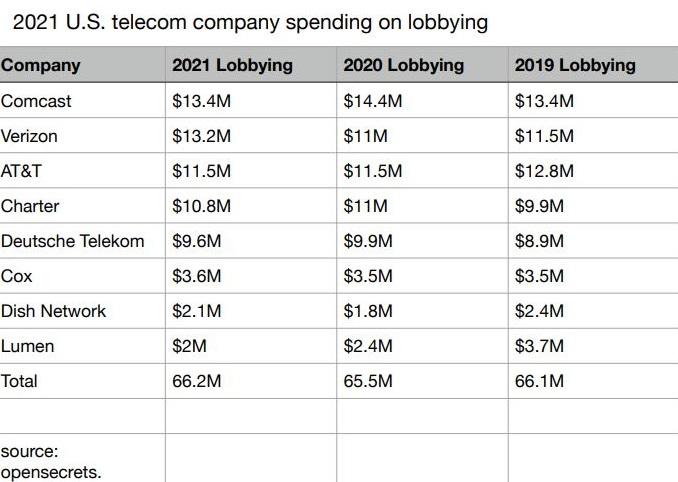
For most major corporations, using lobbyists to shape legislation and regulation is an integral part of business. In the U.S., eight of the largest telecom and cable operators spent $66.2 million in 2021 to pay lobbyists to champion their causes in Washington, D.C., according to data from Opensecrets, a watchdog group that was formed by the Center for Responsive Politics and the National Institute on Money in Politics.
Although $66.2 million may seem like a lot of money, it was only a slight increase from 2020 when the same eight companies spent a total of $65.5 million on lobbying. And that $66.2 million figure in 2021 doesn’t include vendors like Ericsson and Qualcomm, tower firms such as American Tower and Crown Castle, or smaller operators like TDS or Altice, which also devote hundreds of thousands of dollars every year to lobbying efforts.
Of the eight companies that I researched, Comcast came in first place in 2021, spending $13.4 million. And while that figure seems like a lot, it was a decrease from the $14.4 million Comcast spent in 2020.

Verizon was a close second to Comcast with $13.2 million in lobbying fees for the year, which was an increase from $11 million in 2020.
AT&T spent $11.5 million in 2021 (it spent the same amount in 2020), followed by Charter Communications, which spent $10.8 million in 2021, just a slight decrease from the $11 million it spent in 2020. Deutsche Telekom (which is the majority owner of T-Mobile), spent $9.6 million, which is slightly less than the $9.9 million it spent in 2020.
Dish Network, surprisingly, spent significantly less than its telecom peers. The company paid just $2.1 million for lobbying in 2021, which was an increase from the $1.8 million it spent in 2020.
Interestingly, these telecom and cable operators are also members of lobbying organizations such as the NCTA, which represents broadband and pay-TV companies, and CTIA, which represents wireless companies. And these lobbying groups also spend millions on lobbying.
In 2021 NCTA spent $14 million on lobbying and CTIA spent $12.4 million, according to Opensecrets.
Lobbying for what?
Even though these companies are fierce competitors, they share many of the same goals when it comes to legislation and regulation. In 2021 there was a common theme in much of the legislation that these companies supported with lobbying dollars — expanding broadband infrastructure and eliminating the digital divide.
The Infrastructure Investment and Jobs Act, a bipartisan infrastructure bill that allocates a total of $65 billion for broadband improvements, garnered a lot of lobbying attention from telecom players because it recognized the importance of delivering broadband to the underserved.
And for wireless companies like Verizon, AT&T and T-Mobile, this bill was particularly important because it acknowledged that 5G fixed wireless access was a viable home broadband solution.
Other key initiatives in 2021 were the Consolidated Appropriations Act of 2021 and the American Rescue Plan Act because they offer billions of broadband-related dollars to companies to help build broadband networks and expand support for digital equity.
RELATED: 5G FWA study supports bid for more mid-band spectrum
Not surprisingly, spectrum was another hot lobbying topic in 2021 and companies like AT&T and Verizon supported the Spectrum Innovation Act which seeks to free up to 200 megahertz of spectrum in the 3.1-3.45 GHz band for mobile broadband.
From 2019 to 2021 dollars spent on lobbying among the top telecom and cable operators has remained pretty stable with only a few fluctuations. What will telecom lobbying spending look like in 2022 Spectrum scarcity and demands for better broadband will likely continue to be a focus for these companies. But I suspect we will see an increase in lobbying budgets among some companies if the C-band battle with airlines continues to disrupt 5G deployments or if the pandemic continues to disrupt supply chains and impact fiber deployments.

